Austevoll Seafood Bundle
Who Really Owns Austevoll Seafood?
Understanding the ownership structure of a company is crucial for grasping its strategic direction and future prospects. The Austevoll Seafood SWOT Analysis can provide valuable insights into the company's internal and external factors. As the global seafood industry undergoes significant shifts, knowing who controls a major player like Austevoll Seafood becomes even more critical. This deep dive explores the evolution of Austevoll ownership.
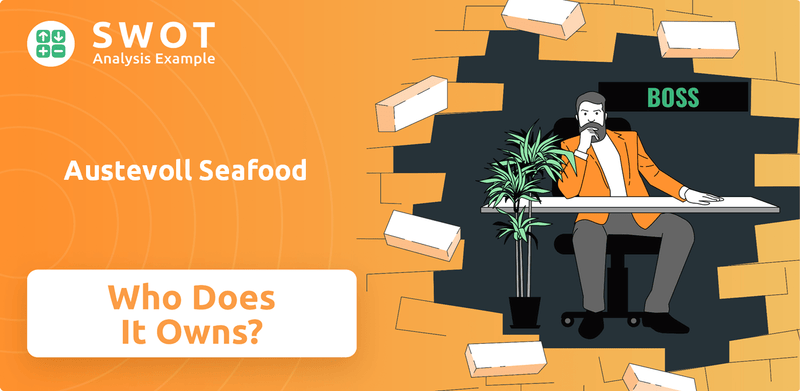
Austevoll Seafood, a leading Norwegian seafood company, has grown from a family-led enterprise to a publicly traded entity. This transformation has reshaped its ownership profile, influencing its strategic decisions and market position. Examining the details of Austevoll ownership, including major shareholders and key personnel, is essential for anyone seeking to understand the dynamics of the fishing industry and the company's long-term trajectory. The company's history reveals how its ownership has shaped its sustainability practices and its relationship with other industry players like Lerøy Seafood Group.
Who Founded Austevoll Seafood?
The foundation of the Austevoll Seafood company rests on its origins with the Møgster family. Founded in 1981, the company's early structure was heavily influenced by the family's deep roots within the Norwegian fishing industry. This familial involvement was crucial in establishing the company and setting its initial course.
Ole Rasmus Møgster played a key role in the company's inception. The Møgster family's vision was to create a vertically integrated seafood operation. This meant controlling all aspects of the business, from catching the fish to delivering it to consumers. This approach allowed for greater control over quality and efficiency.
Details regarding the exact equity splits at the company's beginning are not readily available in public records. However, it is known that the initial ownership was concentrated within the Møgster family. This structure is common among family-owned businesses in Norway's seafood sector. The early focus on sustainable harvesting and value-added processing reflects the company's commitment from the start.
The Møgster family established Austevoll Seafood. Their experience in the Norwegian fishing industry was essential.
Initial ownership was primarily within the Møgster family. This structure is typical for Norwegian seafood companies.
The company aimed for a vertically integrated seafood operation. This included all stages from catch to consumer.
Initial funding likely came from the family and traditional banking. Details about angel investors are not widely available.
The family's involvement ensured a long-term vision. This minimized early ownership disputes.
From the start, the company focused on sustainable harvesting. Investments were made in vessels and processing.
The early years of Austevoll Seafood were defined by the Møgster family's ownership and vision. Their commitment to a vertically integrated model and sustainable practices set the stage for future growth. While specific financial details from the company's inception are not readily available, the family's influence and control were central to the company's development.
- The Møgster family founded Austevoll Seafood in 1981.
- The company's early focus was on vertical integration, controlling the entire seafood value chain.
- Initial ownership was primarily concentrated within the Møgster family.
- The company's commitment to sustainability was evident from the beginning.
Austevoll Seafood SWOT Analysis
- Complete SWOT Breakdown
- Fully Customizable
- Editable in Excel & Word
- Professional Formatting
- Investor-Ready Format
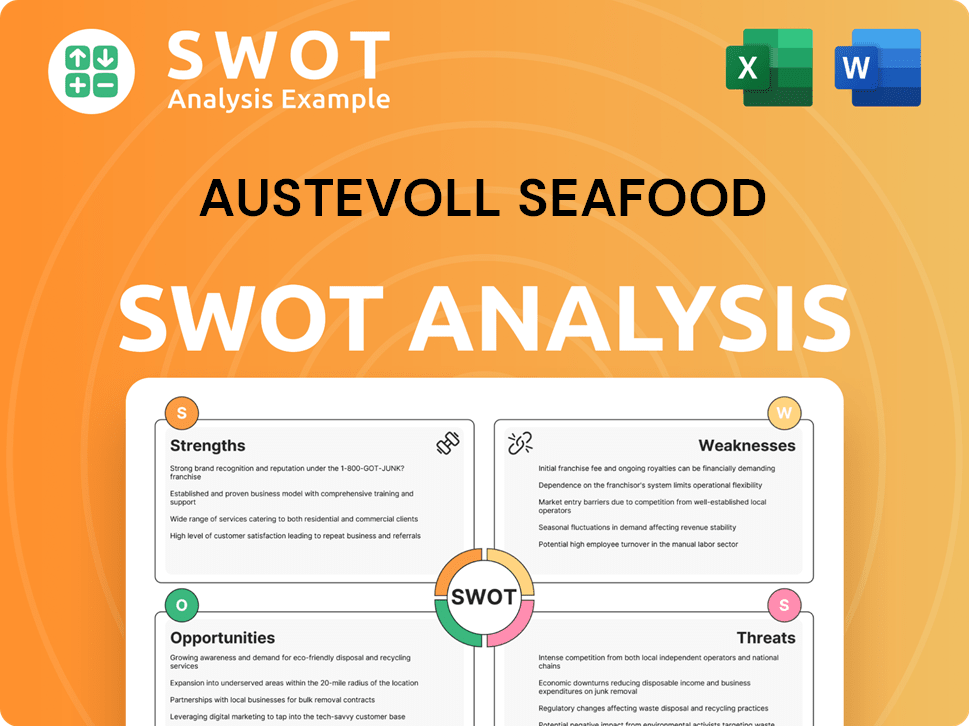
How Has Austevoll Seafood’s Ownership Changed Over Time?
The ownership structure of Austevoll Seafood has transformed significantly since its inception. Initially structured as a closely held family business, the company's trajectory shifted dramatically with its listing on the Oslo Stock Exchange. This move was a pivotal moment, broadening its ownership base and introducing a new era of corporate governance and market dynamics. Understanding the evolution of Austevoll ownership is crucial for grasping its strategic direction within the competitive Norwegian seafood market.
As of April 2025, the Møgster family retains a significant influence over Austevoll Seafood. This influence is primarily exerted through Laco AS, a company controlled by the Møgster family, which holds a substantial portion of the shares. This dominant position allows the family to maintain considerable control over the company's strategic decisions and overall governance. The transition from a private entity to a publicly listed company reflects a common trend in Norway, where family-driven businesses often seek access to capital markets while preserving long-term strategic oversight.
| Event | Impact on Ownership | Date |
|---|---|---|
| Founding of Austevoll Seafood | Initial ownership by the Møgster family | Early years |
| Initial Public Offering (IPO) | Broadened ownership base, introduction of institutional investors | Date of IPO |
| Acquisition and Divestitures | Changes in the number of shares and ownership percentages | Ongoing |
Beyond the Møgster family, institutional investors play a vital role in Austevoll Seafood's shareholder base. These investors include various investment funds, pension funds, and asset managers, both domestic and international, who have acquired stakes in the company through the public market. For example, Folketrygdfondet, a key player in the Norwegian market, often holds significant positions in major Norwegian companies. The presence of institutional investors brings increased scrutiny and demands for transparency and robust corporate governance, which is essential for the Growth Strategy of Austevoll Seafood. While specific percentages for all institutional holdings fluctuate, their collective stake represents a material portion of the free float, contributing to the company's overall market capitalization and stability.
The Møgster family, through Laco AS, remains the largest shareholder, maintaining significant control over the company.
- Institutional investors, including investment and pension funds, hold a substantial portion of the shares.
- The company's annual reports provide detailed breakdowns of major shareholders.
- The ownership structure reflects a balance between family control and access to capital markets.
- Understanding the ownership structure is key to assessing the company's strategic direction within the Norwegian seafood and fishing industry.
Austevoll Seafood PESTLE Analysis
- Covers All 6 PESTLE Categories
- No Research Needed – Save Hours of Work
- Built by Experts, Trusted by Consultants
- Instant Download, Ready to Use
- 100% Editable, Fully Customizable
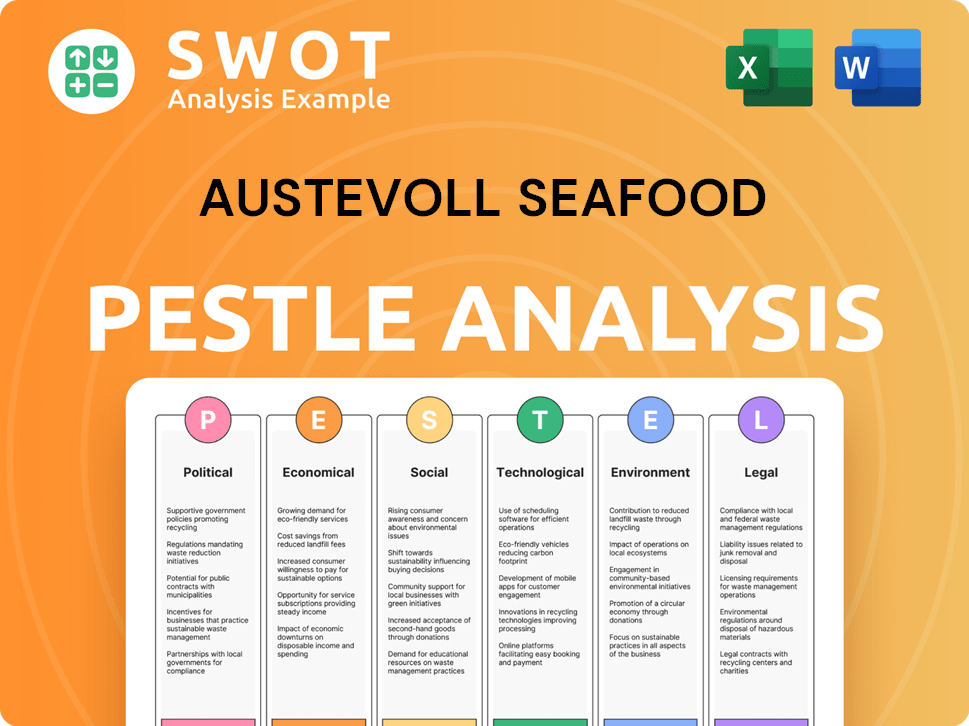
Who Sits on Austevoll Seafood’s Board?
As of April 2025, the Board of Directors of Austevoll Seafood ASA is structured to balance the interests of major shareholders, especially the Møgster family, with independent members. The board typically includes individuals with extensive experience in the seafood industry, finance, and corporate governance. Key board members often have direct ties to Laco AS, which represents the Møgster family's controlling interest. Helge Møgster serves as the Chairman of the Board, highlighting the family's ongoing central role in the company's governance.
The board's composition aims to ensure good corporate governance while aligning with the interests of the controlling shareholders. This structure is common for companies listed on the Oslo Stock Exchange and reflects the company's commitment to maintaining a balance between shareholder influence and independent oversight. This approach helps to foster stability and long-term value creation within the company, as detailed in a brief history of Austevoll Seafood.
| Board Member | Role | Affiliation |
|---|---|---|
| Helge Møgster | Chairman | Laco AS |
| (Information not available) | Board Member | (Information not available) |
| (Information not available) | Board Member | (Information not available) |
Austevoll Seafood operates with a one-share-one-vote voting structure. The significant ownership stake held by Laco AS effectively grants the Møgster family outsized control through their majority voting power. This concentrated ownership minimizes the likelihood of proxy battles or activist investor campaigns significantly altering decision-making, as the family's voting bloc is substantial enough to largely dictate outcomes on key resolutions. The company's structure ensures that the primary stakeholders' interests are well-represented in the company's strategic direction and operational decisions within the Norwegian seafood market.
The Møgster family, through Laco AS, maintains a significant controlling interest in Austevoll Seafood, influencing board decisions and strategic direction. The board balances family representatives with independent members to ensure good corporate governance. This structure supports the company's long-term stability and strategic goals within the fishing industry.
- Majority voting power rests with the Møgster family.
- Board composition includes both family representatives and independent directors.
- One-share-one-vote voting structure.
- Focus on aligning interests of controlling shareholders with good governance.
Austevoll Seafood Business Model Canvas
- Complete 9-Block Business Model Canvas
- Effortlessly Communicate Your Business Strategy
- Investor-Ready BMC Format
- 100% Editable and Customizable
- Clear and Structured Layout
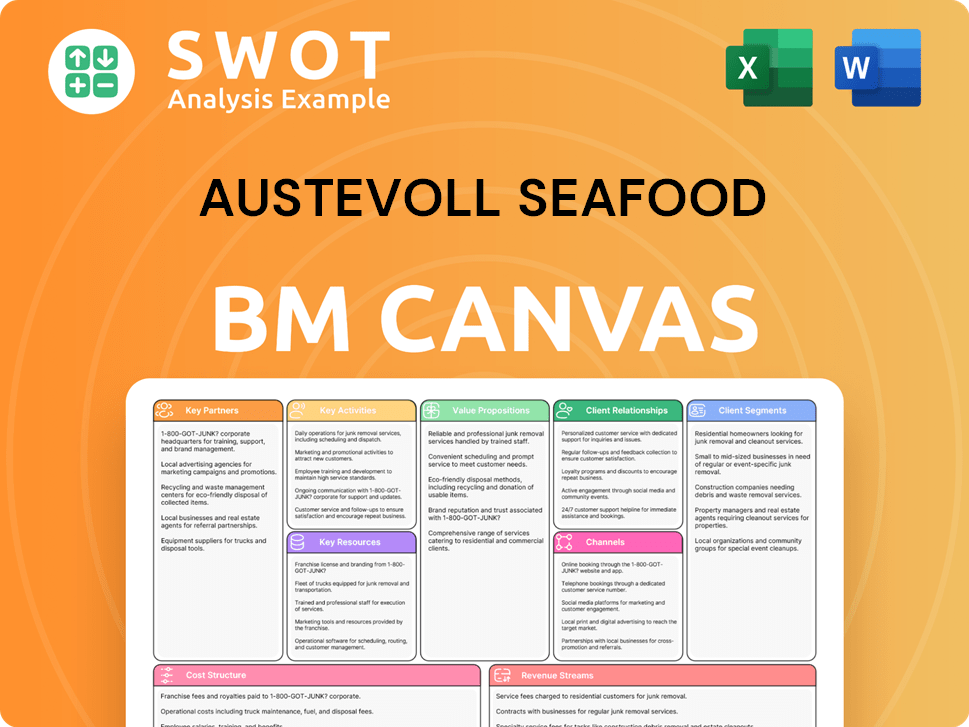
What Recent Changes Have Shaped Austevoll Seafood’s Ownership Landscape?
Over the past three to five years, the ownership structure of Austevoll Seafood has largely remained consistent. The Møgster family, through Laco AS, continues to hold a dominant position, maintaining significant control over the company. Public shareholders, including institutional and individual investors, also participate in the ownership structure. There have been no major shifts, such as substantial share buybacks or significant secondary offerings, that would dramatically alter the ownership dynamics. The company's strategic focus on core operations within the pelagic fish, whitefish, and salmon sectors has persisted, with ownership distribution remaining relatively stable.
The seafood industry faces increasing pressures related to sustainability, consolidation, and technological advancements. These factors can indirectly affect ownership as companies seek capital for expansion or adapt to new regulations. While Austevoll Seafood has addressed these areas operationally, there have been no indications of major ownership changes, such as privatization or a significant new strategic investor taking a major stake. Leadership has remained stable, with the Møgster family maintaining a strong presence, reflecting a long-term strategic vision influenced by their enduring control. The company's consistent performance and strategic focus have contributed to its stable ownership profile.
| Ownership Aspect | Details | Recent Trends |
|---|---|---|
| Major Shareholders | Møgster family (Laco AS), Public Shareholders | Continued dominance by the Møgster family |
| Strategic Focus | Pelagic fish, whitefish, salmon | Consistent focus, no major shifts |
| Industry Influences | Sustainability, consolidation, technology | Indirect impact on ownership, no major changes |
In the context of the fishing industry, the stability of Austevoll Seafood's ownership is notable. The company's consistent performance, as reflected in its financial reports, supports the stability of its ownership structure. The Møgster family's enduring control underscores a long-term commitment to the company's strategic direction and operational excellence. The company's strategic focus on its core operations has also played a role in maintaining its ownership stability.
The Møgster family, through Laco AS, maintains a dominant ownership stake. Public shareholders also participate in the ownership structure. This stability reflects a long-term strategic vision.
Sustainability, consolidation, and technological advancements influence the seafood sector. Austevoll Seafood addresses these areas operationally. No major ownership changes have been reported.
The Møgster family continues to play a strong role in leadership and on the board. This contributes to the company's consistent strategic direction. Leadership stability is a key factor.
Austevoll Seafood's financial performance supports the stability of its ownership. The company's consistent strategic focus plays a role. Stable ownership contributes to long-term value creation.
Austevoll Seafood Porter's Five Forces Analysis
- Covers All 5 Competitive Forces in Detail
- Structured for Consultants, Students, and Founders
- 100% Editable in Microsoft Word & Excel
- Instant Digital Download – Use Immediately
- Compatible with Mac & PC – Fully Unlocked
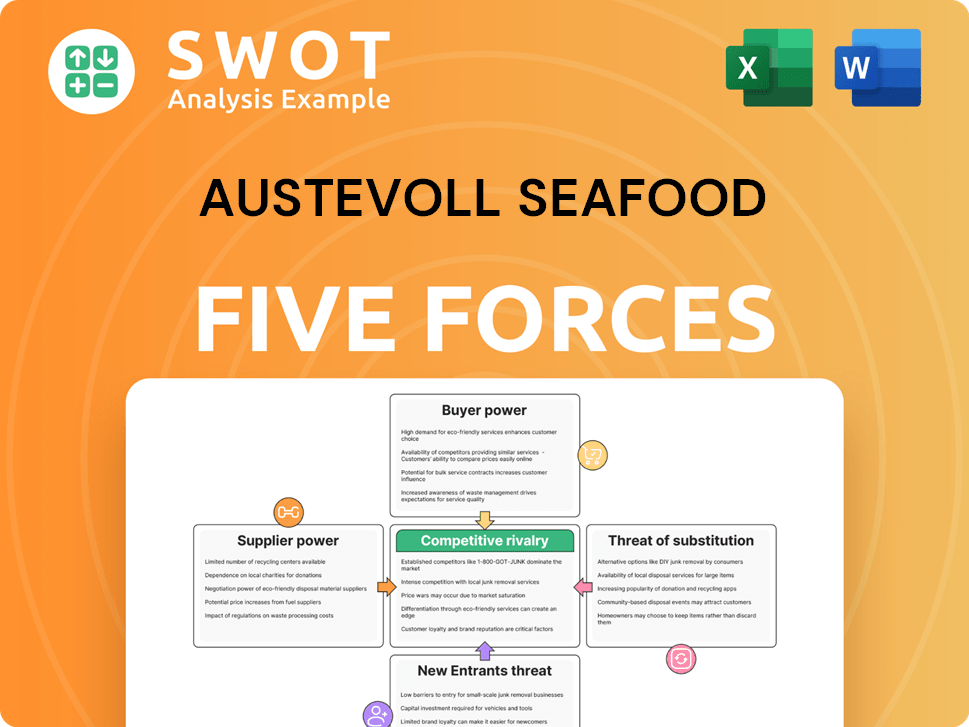
Related Blogs
- What are Mission Vision & Core Values of Austevoll Seafood Company?
- What is Competitive Landscape of Austevoll Seafood Company?
- What is Growth Strategy and Future Prospects of Austevoll Seafood Company?
- How Does Austevoll Seafood Company Work?
- What is Sales and Marketing Strategy of Austevoll Seafood Company?
- What is Brief History of Austevoll Seafood Company?
- What is Customer Demographics and Target Market of Austevoll Seafood Company?
Disclaimer
All information, articles, and product details provided on this website are for general informational and educational purposes only. We do not claim any ownership over, nor do we intend to infringe upon, any trademarks, copyrights, logos, brand names, or other intellectual property mentioned or depicted on this site. Such intellectual property remains the property of its respective owners, and any references here are made solely for identification or informational purposes, without implying any affiliation, endorsement, or partnership.
We make no representations or warranties, express or implied, regarding the accuracy, completeness, or suitability of any content or products presented. Nothing on this website should be construed as legal, tax, investment, financial, medical, or other professional advice. In addition, no part of this site—including articles or product references—constitutes a solicitation, recommendation, endorsement, advertisement, or offer to buy or sell any securities, franchises, or other financial instruments, particularly in jurisdictions where such activity would be unlawful.
All content is of a general nature and may not address the specific circumstances of any individual or entity. It is not a substitute for professional advice or services. Any actions you take based on the information provided here are strictly at your own risk. You accept full responsibility for any decisions or outcomes arising from your use of this website and agree to release us from any liability in connection with your use of, or reliance upon, the content or products found herein.